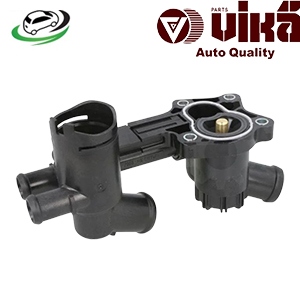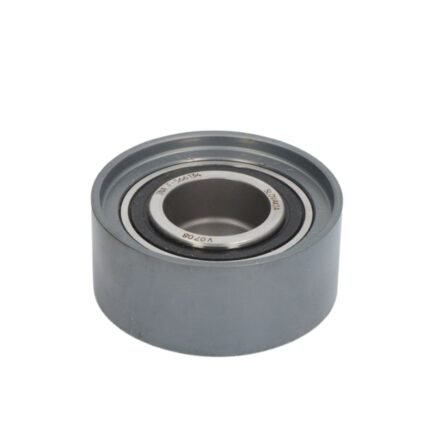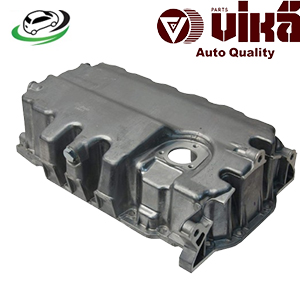Get AUDI A3 8P TDI / VW Golf VI/ Jetta V/ Jetta VI All TDI Oil Pan 03G103603AD
The oil pan, often referred to as the oil sump, is a critical component in an internal combustion engine. It serves as the reservoir for engine oil, providing essential lubrication to various engine parts. The oil pan plays a significant role in the overall health and performance of an engine, and understanding its design, function, maintenance, and potential issues can help vehicle owners ensure their engines operate smoothly. This guide will explore the oil pan’s function, importance, types, common issues, maintenance practices, and its impact on engine performance.
1. What is an Oil Pan?
The oil pan is a metal container located at the bottom of the engine block. Its primary function is to hold engine oil, which lubricates the moving parts of the engine, preventing friction and wear. The oil pan is typically made from stamped steel, aluminum, or composite materials, and it is sealed to the bottom of the engine block with a gasket to prevent leaks.
2. Function of the Oil Pan
A. Oil Reservoir
The oil pan acts as a reservoir for engine oil. It holds the oil when the engine is not running, allowing it to drain back into the pan after the oil has circulated through the engine. This ensures that there is always a sufficient supply of oil available when the engine is started.
B. Lubrication System Support
The oil pan is integral to the engine’s lubrication system. When the engine starts, the oil pump draws oil from the pan and circulates it through various engine components, including bearings, camshafts, and the crankshaft. This lubrication reduces friction between moving parts, preventing wear and overheating.
C. Cooling Function
As engine oil circulates through the engine, it absorbs heat generated by combustion and friction. The oil pan helps dissipate this heat by allowing the oil to flow back into the pan, where it can cool down before being recirculated. Some oil pans may have integrated cooling fins or designs to enhance cooling efficiency.
D. Debris Collection
The oil pan also serves as a collection point for contaminants and debris that accumulate in the engine oil. Over time, particles from wear and combustion can build up in the oil. The oil pan allows these contaminants to settle at the bottom, making it easier for oil filters to remove them when the oil is circulated.
3. Importance of the Oil Pan
A. Engine Protection
The oil pan is crucial for protecting the engine from damage. Proper lubrication is essential for preventing metal-to-metal contact between moving parts. A well-functioning oil pan ensures that the engine is adequately lubricated, reducing the risk of wear, overheating, and catastrophic engine failure.
B. Optimal Engine Performance
An efficient oil pan contributes to optimal engine performance. By maintaining the right oil level and ensuring proper oil circulation, the oil pan helps the engine achieve its designed performance metrics, including horsepower, torque, and fuel efficiency.
C. Contaminant Management
By allowing contaminants to settle, the oil pan helps maintain cleaner oil in the lubrication system. Cleaner oil reduces wear on engine components and prolongs their lifespan, contributing to overall engine health.
D. Maintenance Indicator
Regular checks of the oil level in the pan can serve as an indicator of the engine’s health. Low oil levels may suggest leaks, excessive consumption, or contamination, signaling the need for maintenance or repair.
4. Types of Oil Pans
A. Wet Sump Oil Pan
The wet sump oil pan is the most common type used in modern vehicles. In this system, the oil is stored in the pan at the bottom of the engine. The oil pump draws oil directly from the pan and circulates it through the engine. Wet sump systems are generally simpler, more cost-effective, and easier to maintain than dry sump systems.
B. Dry Sump Oil Pan
Dry sump oil pans are typically found in high-performance and racing engines. In this system, the oil is stored in a separate tank, and the oil pump circulates it through the engine. This design allows for better oil management, reduces the risk of oil starvation during high-G maneuvers, and helps lower the engine’s center of gravity. However, dry sump systems are more complex and costly compared to wet sump systems.
C. Modified Oil Pans
Some engines may have modified oil pans designed to accommodate specific performance needs. For example, aftermarket oil pans may have increased capacity, baffles to prevent oil slosh during cornering, or additional cooling features. These modifications can enhance engine performance and reliability.
5. Common Issues with Oil Pans
A. Oil Leaks
One of the most common issues with oil pans is leaks. Over time, the gasket that seals the oil pan to the engine block can wear out, leading to oil leaks. Additionally, impacts or corrosion can damage the oil pan itself, resulting in leaks. Oil leaks can lead to low oil levels, which can cause severe engine damage.
B. Cracks and Damage
The oil pan can become cracked or damaged due to road debris, corrosion, or improper installation. Cracks can lead to oil leaks and may require the replacement of the oil pan. Regular inspections can help identify damage early before it leads to significant issues.
C. Clogged Oil Pan
Over time, sludge and debris can accumulate in the oil pan, leading to clogs. A clogged oil pan can restrict oil flow to the engine, resulting in inadequate lubrication and potential engine damage. Regular oil changes and maintenance can help prevent clogging.
D. Contaminated Oil
The oil pan serves as a reservoir for engine oil, which can become contaminated over time. Contaminants can lead to increased wear on engine components, reducing their lifespan and efficiency. Regular oil changes are essential for maintaining oil cleanliness.
6. Maintenance of Oil Pans
A. Regular Oil Changes
One of the most effective ways to maintain the oil pan and its contents is to perform regular oil changes. Fresh oil helps reduce sludge buildup and keeps contaminants in check, ensuring optimal engine lubrication.
B. Inspect for Leaks
Regularly inspect the oil pan and its gasket for signs of leaks. Look for oil spots under the vehicle or wet areas around the oil pan. If leaks are detected, address them promptly to prevent low oil levels and potential engine damage.
C. Check Oil Levels
Regularly check the oil level using the dipstick. Low oil levels may indicate leaks or excessive consumption, necessitating immediate attention. Maintaining the proper oil level is crucial for engine health.
D. Clean the Oil Pan
If the oil pan becomes clogged or dirty, consider cleaning it during an oil change. Removing sludge and contaminants can help maintain proper oil flow and engine lubrication.
E. Consider Upgrades
If you have a high-performance vehicle or engage in motorsport activities, consider upgrading to a dry sump oil system or a modified oil pan designed for enhanced performance and reliability. These upgrades can help prevent oil starvation and improve engine longevity.
7. Conclusion
The oil pan is a vital component of an engine’s lubrication system, serving as the reservoir for engine oil and supporting overall engine performance. Understanding its function, importance, and common issues can help vehicle owners appreciate its role in maintaining engine health and performance.
Regular maintenance practices, including oil changes, inspections for leaks, and monitoring oil levels, are essential for ensuring the oil pan operates effectively. By prioritizing the health of the oil pan, vehicle owners can protect their engines from wear and damage, ensuring optimal performance and longevity. Whether driving a daily commuter or a high-performance machine, understanding and caring for the oil pan is crucial for a well-functioning engine.
Follow us on Facebook for more parts.




Reviews
Clear filtersThere are no reviews yet.